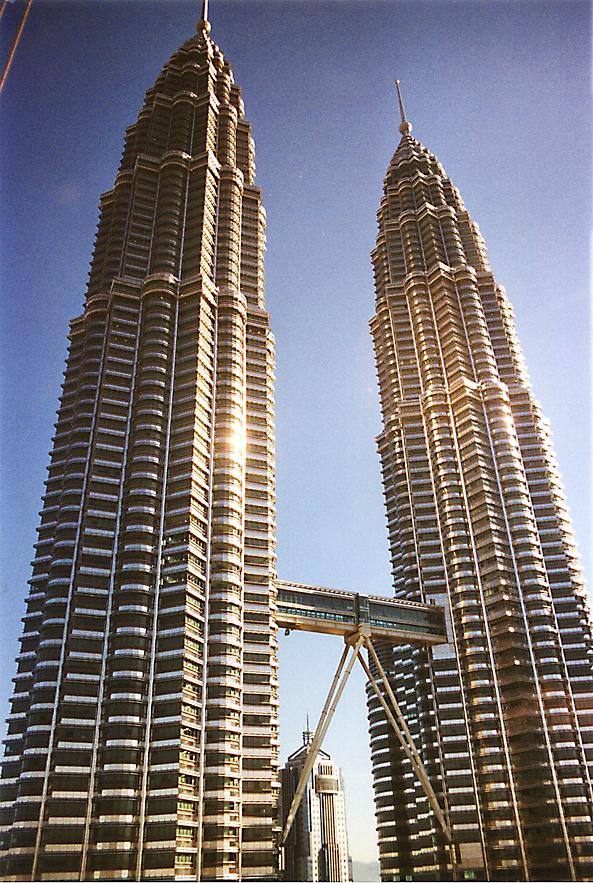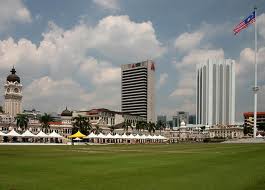

Sri Kedawang official website for tourism and travel information
TRAVEL & TOURS (W) SDN BHD
Copyright @ 2010 Sri Kedawang Travel & Tours













Kuala Lumpur or simply KL, is the capital of Malaysia. Literally meaning "muddy estuary" in Malay, KL has grown from a small sleepy Chinese tin-mining village to a bustling metropolis of around 6.5 million (city-proper population of 1.8 million) in just 150 years. With some of the world's cheapest 5-star hotels, great shopping and even better food, increasing numbers of travellers are discovering this little gem of a city.
Districts
Kuala Lumpur is quite a sprawling city and its residential suburbs seem to go on forever. The city also merges with the adjacent towns of Petaling Jaya (originally developed as KL’s satellite town), Subang Jaya, Shah Alam, Klang and Port Klang, creating a huge conurbation called the Klang Valley.
The city can be divided into the following areas, each of which offers a particular attraction or activity.
•City Centre – This is the traditional core of Kuala Lumpur where you’ll find the former colonial administrative centre, with the Merdeka Square, Sultan Abdul Samad Building and Selangor Club. This district also includes Kuala Lumpur’s old Chinese commercial centre which everyone refers to now as Chinatown.
•Golden Triangle – The area of Kuala Lumpur located to the north-east of the city centre, the Golden Triangle is where you’ll find the city’s shopping malls, five-star hotels, Petronas Twin Towers and party spots.
•Tuanku Abdul Rahman / Chow Kit – This is the traditional colourful shopping district of Kuala Lumpur north of the city centre that moves into high gear when the festivals of Hari Raya Puasa (Eid ul-Fitr) and Deepavali approach. Located just beside the Golden Triangle (northern neighbour) with many popular budget accommodations. The gigantic Putra World Trade Centre & the traditional Kampung Baru food haven are among the most important landmarks.
•Brickfields – This area, located south of the city centre, is Kuala Lumpur’s Little India filled with saree shops and banana leaf rice restaurants. Kuala Lumpur’s main railway station – KL Sentral – is located here.
The Eye On Malaysia•Bangsar and Midvalley – Located south of the city, Bangsar is a popular restaurant and clubbing district while Midvalley, with its Megamall, is one of the city’s most popular shopping destinations.
•Damansara and Hartamas – Largely suburban, these two districts to the west of the city house some interesting pockets of restaurants and drinking areas.
This district also merges into the northern part of Petaling Jaya.
•Ampang – Located east of the city, Ampang is home to Kuala Lumpur’s Little Korea and most foreign embassies.
•Northern suburbs – This huge area to the north of the city is home to several attractions, such as the Batu Caves, the National Zoo and the Forest Research Institute of Malaysia.
•Southern suburbs – This district may not interest travellers much, although Kuala Lumpur’s main stadium at Bukit Jalil and The Mines theme park are located here.
[edit] Understand
Merdeka!
Prior to independence, Malaya was a British colony. When Malaya's independence, to be attained on 31 August 1957, was approved by the British Government in 1956, the first Prime Minister Tunku Abdul Rahman announced it to the public in Malacca at what is today Dataran Pahlawan.
On the evening of 30 August 1957, crowds gathered at what was then known as the Selangor Club Padang (Green) to celebrate the historic event. As the clock on the State Secretariat Building (today's Sultan Abdul Samad Building) struck 12 midnight, the crowds, led by Tunku Abdul Rahman, shouted "Merdeka!" seven times. The Union Jack was lowered and the flag of the new country was raised to the strains of the national anthem, Negaraku. The Selangor Club Padang is today known as Dataran Merdeka (Independence Square). The next day, the official handing over of power by the British was held at Stadium Merdeka (Independence Stadium).
The country was renamed Malaysia on September 16, 1963, when Singapore, Sabah, Sarawak and Malaya formed a new federation.
Founded only in 1857 as a tin mining outpost, Kuala Lumpur is fairly new as far as Malaysian cities go and lacks the rich history of George Town or Malacca. After rough early years marked by gang fighting, Kuala Lumpur started to prosper and was made capital of the Federated Malay States in 1896. Malaysia's independence was declared in 1957 in front of huge crowds at what was later named Stadium Merdeka (Independence Stadium), and Kuala Lumpur continued as the new nation's capital. The economic boom of the 1990s brought KL the standard trappings of a modern city, bristling with skyscrapers and modern transportation systems. Like most of Malaysia's big cities, about 55% of Kuala Lumpur's population is of Malaysian Chinese descent.
Kuala Lumpur International Airport (KLIA)
All scheduled air flights, whether domestic or international, arrive at the Kuala Lumpur International Airport [2] (IATA: KUL ICAO: WMKK) located about 50km to the south of Kuala Lumpur, in the Sepang district of Selangor. The US$2.5bil modern structure of glass and steel was inaugurated in 1998 and has been ranked as one of the top airports of the world. It replaced the former Sultan Abdul Aziz Shah International Airport in Subang, which is now used for chartered and turboprop flights. Over 50 airlines call at KLIA.
A new Low Cost Carrier Terminal (LCCT) opened in March 2006, and is currently used by AirAsia [3], Tiger Airways [4], and Cebu Pacific [5]. Though the LCC Terminal is across the runway tarmac from the Main Terminal Building, it is nearly 20km away by road. Frequent shuttle buses connect the two terminals, costing RM2.50 per trip. At the Main Terminal Building, catch the shuttles at the Bus Terminal on the Ground Floor of the Car Park C building, while at the LCCT, wait for the buses at the bus bays right in front of the terminal. If transferring from the KLIA Ekspres train, make your way to Level 2 and follow the signs to Car Park C and the Bus Station.
Kuala Lumpur International Airport's TerminalBe careful when locating the transfer bus from the main terminal to the LCCT, as taxi drivers giving the appearance of being airport customer service personnel will try to steer tourists to a mini-bus or taxi with a cost many times greater than the actual LCCT transfer bus. Frequently they will ask for a fee similar to a taxi ride into Kuala Lumpur, typically RM90.
Transfers - Main Terminal
By train:
•The KLIA Ekspres links the airport directly with the KL Sentral transportation hub in Kuala Lumpur in 28 minutes. Trains run from 5AM to 12 midnight. There is one train every 15 minutes between 5AM and 9AM, and between 4PM and 10PM; while trains run every 20 minutes outside those hours. The cost of a one-way ticket is RM35. There is no discount on return tickets. If flying Malaysia, Emirates, Cathay or Royal Brunei, you can also check in your baggage at the Kuala Lumpur City Air Terminal in KL Sentral. See "Get around" section below on how to get to/away from KL Sentral.
•The KLIA Transit like the KLIA Ekspres, also links the airport with KL Sentral except that it stops at three intermediate stations - Salak Tinggi, Putrajaya, and Bandar Tasik Selatan. The journey takes 36 minutes. The fare from end to end is the same as for the KLIA Ekspres, which is RM35. Different fares apply for journeys to the intermediate stations. From KL Sentral, trains run every half hour from 5.33AM to 12.03AM, while from KLIA, trains run every half hour from 5.52AM to 1AM. You may use the KLIA Ekspres' check-in services even when holding a KLIA Transit ticket.
•You can also catch KTM Komuter trains to Nilai station and take a connecting bus to KLIA. The frequent Nilai-KLIA buses are operated by Airport Coach and Sepang Omnibus. The entire journey may take about two hours, but the cost is considerably cheaper than the above two options. For example, the fare from KL Sentral to Nilai is RM4.70 while the bus fare from Nilai to KLIA is about RM2.50. You can also use the KTM Komuter to go to other destinations, such as Seremban in Negeri Sembilan. For other KTM Komuter destinations, see "Get around" section below.
By bus:
•Airport Coach runs a one hourly express bus between KL Sentral and KLIA from 5AM to 10.30PM from Sentral, and 6.30AM to 12.30AM from KLIA. RM10 one way, or RM18 return.
•Star Shuttle bus runs from KLIA to Kota Raya and Pudu Raya (both are near the Chinatown), RM10 one way.
•Sepang Omnibus runs local bus services directly to Seremban in Negeri Sembilan, Banting in Selangor and Sepang town where you can get connecting buses to/from Port Dickson, Negeri Sembilan. The buses may be a little basic and uncomfortable, and do not follow a timetable (at least, not one that is publicly known).
•Both Airport Coach and Sepang Omnibus run frequent buses between KLIA and Nilai where you continue your journey on the KTM Komuter. See the "Get around" section below for details on the KTM Komuter.
Alternatively, you can take the bus to the LCCT then connect to KLIA.
Note that taxis hovering outside, near where the airport shuttle buses depart from, will try to get your business claiming that trains and the Monorail are not working, or finished for the day. Always check these schedules before believing a word the taxi drivers say.
By taxi:
WARNING: Do not to accept offers from touts in the arrival foyer because they usually charge more than Airport Limo taxis. Even if you are shown what seems to be legitimate price lists. These touts are usually drive private vehicles not meant to ferry passengers and the drivers do not have PSV (public service vehicle) licenses to take passengers. You will also not be covered by insurance if an accident happens.
•From KLIA: Only Airport Limo limousines and budget taxis are allowed to pick up passengers at the airport. You buy coupons from Airport Limo counters just before you exit the international arrivals gate, or just outside the domestic arrivals gate. Ask for a budget taxi, which is perfectly fine and costs a fixed RM 74.80 to get to Kuala Lumpur; otherwise you'll be given a misnamed "premier" car that costs an extra RM25. If there is more than one person, it is probably cheaper to take a taxi directly to your destination, rather than going by train and then having to take a taxi onto your destination.
•To KLIA: Any taxi can bring passengers to KLIA, including Kuala Lumpur's metered red-and-white taxis, although you will find it very difficult to get drivers to use the meters. Make sure you agree on a price before getting into the taxi. Fares should be between RM80 and RM100. For your information, in December 2009, I took a taxi from Jalan Ipoh (downtown of KL) by meter, and it cost around RM 70, plus additional airport surcharge RM12 and some toll fees (taxis only pay half the normal toll fees), totally became RM 90).
By road:
If you have your own wheels, KLIA is well connected to Peninsular Malaysia's expressway network. The airport is directly linked with the North South Expressway Central Link (known by its Malay abbreviation "Elite") about 70km or nearly one hour away from Kuala Lumpur city centre. Exit the expressway at KLIA interchange for both the Main Terminal and LCCT.
Transfers - Low Cost Carrier Terminal (LCCT)
By train:
•There are no direct train connections to the LCCT (although the government has agreed to build one). However, you can buy a "KLIA Transit to LCCT" ticket (RM 12.50/22 one-way/return), which covers the KLIA Transit to the ERL Salak Tinggi Station and a free connecting bus to the LCCT.
By bus:
•SkyBus runs direct services every half hour or so from KL Sentral to the LCCT. RM9 one-way.
•Aerobus also runs direct bus services every half hour from KL Sentral to the LCC Terminal. RM8 one-way, RM14 return journey.
•Star Shuttle (Tel: +60-3-40438811) has direct buses to the Pekeliling Bus Terminal and Batu 3 (3rd Mile) Jalan Ipoh in Kuala Lumpur, as well as direct connections to the Subang Jaya KTM Komuter station and the PKNS Building in Shah Alam. Check its website for schedules. Fares are RM9 per trip.
By road:
The LCCT is about 20km from the Main Terminal and can be accessed via the KLIA circular or airport cargo road.
Note: The Government is planning a newer, larger and more permanent LCCT Terminal closer to the Main Terminal Building but this is not expected to be ready for several years.
Subang Airport
The Sultan Abdul Aziz Shah Airport (IATA: SZB) (ICAO: WMSA), more commonly referred to as the Subang Airport, was the country's main international airport until KLIA was opened in 1998. As it is much nearer to the city centre and less crowded than the newer KLIA, it can make a convenient entry point for those flying from Singapore or other parts of Malaysia. After the opening of KLIA, it was designated for turboprop aircraft and is currently served by two airlines:
•Malaysia Airlines subsidiary Firefly began operating from Subang in late 2007, flying initially to Penang twice daily but now serves a whole range of destinations with new ATR aircraft in Peninsular Malaysia, Indonesia, Singapore and to Ko Samui and Phuket in Thailand.
•Berjaya Air [14] flies daily to/from Tioman Island, five times a week to/from Pangkor Island, and special flights to Redang Island. It also has two flights weekly to/from Ko Samui in Thailand.
Getting there/away: The airport is 25 km from the city centre and the best way to get there is by taxi. Rapid KL bus U81 (destination Mah Sing and Pekan Subang) from the Sultan Mohd Bus Hub next to the Pasar Seni LRT station goes past the airport. The fare is RM2.50 one way and takes approximately 40 minutes in clear traffic. It can take nearly 1 hour and 30 minutes during peak rush hour.
By road
Most important roads in Peninsular Malaysia lead to/from Kuala Lumpur. The city lies about midway along the North-South Expressway (Motorway) (NSE; route numbers E1 and E2) which runs from the Malaysia-Thailand border at Bukit Kayu Hitam, Kedah to Johor Bahru in the south, on the Malaysian side of the Causeway to Singapore. The main expressway exits for Kuala Lumpur on the NSE are Jalan Duta (from the north) and Sungai Besi (from the south).
A view from Dataran MerdekaThe Karak Highway (E8), which later turns into the East Coast Expressway, links Kuala Lumpur with the East Coast states of Pahang, Terengganu and Kelantan.
For those who do not want to pay toll, Kuala Lumpur is on Federal Route One (the "Trunk Road") which, like the NSE, runs through all West Coast states of Peninsular Malaysia from Bukit Kayu Hitam, Kedah to Johor Bahru.
Those travelling along the West Coast Road (Federal Route Five) should leave the road at Klang and get to Kuala Lumpur via the Federal Highway.



